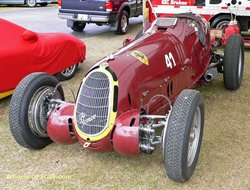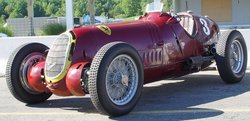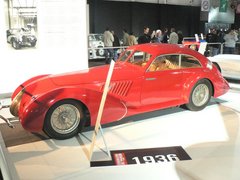Alfa Romeo 8C
- This article is about the 1930's Alfa Romeo 8C. For the upcoming sports coupe, see Alfa Romeo 8C Competizione.
The Alfa Romeo 8C name was used on road, race and sports cars of the 1930s. The 8C means 8 cylinders, and originally referred to a straight 8 cylinder engine. The Vittorio Jano designed 8C was Alfa Romeo's primary racing engine from its introduction in 1931 to its retirement in 1939. In its later development it powered such vehicles as the twin engined 1935 6.3 litre Bimotore, the 1935 3.8 litre Monoposto 8C 35 Type C, and the Alfa Romeo 8C 2900B Mille Miglia Roadster. It also powered top of the range coachbuilt production models. In 2004 Alfa Romeo revived the 8C name for a V8 engined concept car which has made it into production for 2007, the Alfa Romeo 8C Competizione.
History

| |
| Alfa Romeo Monoposto Type C | |
|---|---|
| Aka | Alfa Romeo 8C 35 |
| Manufacturer | Alfa Romeo |
| Parent company | |
| Production | 1935 - 1939 |
| Assembly | Italy |
| Predecessor | Alfa Romeo Monoposto 8C Type B |
| Successor | Alfa Romeo Monoposto 12C 37 |
| Class | Race |
| Body style | Monoposto (single seat) open wheeler |
| Layout | Multi-plate clutch at engine, four-speed rear transaxle. |
| Platform | Light gauge welded box-section frame with all independent suspension |
| Engine | Supercharged 3822 cc straight eight twin overhead cam |
| Transmission | Unsynchronised rear transaxle four speed with reverse gear |
| Wheelbase | 108.2 inches (2748.28 mm) |
| Length | 169.3 inches (4300 mm) including starting handle |
| Width | 34.0 inches (863.6 mm) cockpit |
| Height | 48.0 inches (1219.2 mm) cowl 52.0 inches (1320.8 mm) windscreen |
| Ground clearance | 5-6 inches (125-150 mm) |
| Front track | 53.1 inches (1348.74 mm) |
| Rear track | 53.1 inches (1348.74 mm) |
| Weight | 1646 lb (746.613 kg) unladen |
| Fuel capacity | |
| Related | |
| Similar | |
| Designer | Vittorio Jano |
In 1924, Vittorio Jano created his first straight eight cylinder engine, the 1987 cc P2, with common crankcase and four plated steel two cylinder blocks, which was used in racing till 1930, but the 8C designation was not used. The P3 8C engine had a common crankcase, now with two alloy four cylinder blocks, which also incorporated the heads. There was no separate head, and no head gasket to fail, but this made valve maintenance more difficult. A central gear tower drove the overhead camshafts, superchargers and ancillaries. The first model was the 1931 8C 2300, a reference to the car's 2.3 L (2300 cc) engine. Now that racing cars were no longer required to carry a mechanic, Alfa Romeo built the first single seater race car, the Monoposto Tipo B P3 for the 1932 Grand Prix season. This car, driven by Tazio Nuvolari won the 1931 and 1932 Targa Florio race in Sicily, but it was the Italian Grand Prix victory at Monza that gave it its "Monza" name. The Alfa Romeo factory often added the name of events won to the name of a car.
A range of roadster and coupes were available in Lungo (long) or Corto (short) chassis, usually with bodies from a selection of coachbuilders (Carrozzeria), even though Alfa Romeo did make bodies. They also had a practice of rebodying cars for clients, and some racing vehicles were sold rebodied as road vehicles. While the more expensive 8C engine ceased production in 1939, 6C engined models continued in production till after WWII. Improvements made to the racing cars often appeared in production models in following years.
In 1933 the supercharged dual overhead cam straight-8 engine was enlarged to 2.6 litres (8C 2600), but Alfa Romeo's economic problems meant most racing was now being done by Scuderia Ferrari. In this guise, the Monoposto 8C Type B (P3) racer could accelerate to 60 mph (97 km/h) in less than 7 seconds and could eventually reach 135 mph (217 km/h). For 1934 the race engines became 2.9 litres.
In 1935 the 8C 2900A production models were introduced, still using the live rear axle, but only 11 were built in the two years before the 8C 2900B appeared. At the same time Alfa Romeo's Tipo B 3.2 litre was becoming less competitive, but the blocks had reached their capacity limit. The Bimotore and Monoposto 8C 35 Type C 3.8 came into use but the Monoposto 12C 36 and 37 did not perform, and could not match the Mercedes and Auto-Union cars.
The production 1937 2900B gained the stiff chassis and fully independent suspension already in use on the racers.

1935 Bimotore
In 1935, to compete with Mercedes Benz and Auto Union, Enzo Ferrari (Race team manager) and Luigi Bazzi (Designer) built a racer with two 3.2 (3.165 litre) engines, one in the front and one in the rear, giving 6.3 litres and 540 bhp. The drivetrain layout was unusual. The two engines were connected by separate driveshaft to a gearbox with two input shafts, and two angled output shafts, so each of the rear wheels had its own driveshaft. It could never quite succeed against the Mercedes W25 B of Rudolph Caracciola, and was hard on fuel and tyres. The gain in speed was offset by increased pit times. On May 12, 1935, two were entered in the Tripoli Grand Prix driven by Nuvolari and Chiron who finished fourth and fifth. Chiron managed a second at the following 1935 Avus race. After that it was sidelined in favour of the Tipo C. It was the first racer to use the Dubonnet independent trailing arm front suspension. A V12 was under development, but was not race ready. It was noticed that the Bimotore had a traction advantage on rough ground, so a version of the Bimotore chassis with the independent Dubonnet front end, and a new independent rear with swing axles with radius rods and a transverse leaf spring was used for the Tipo C 3.8s.
1935 Alfa Romeo Monoposto 8c 35 Type C
Eight 3.8 litre versions, sharing no castings with the earlier blocks, were individually built for racing in five months, most being used in the Alfa Romeo Monoposto 8c 35 Type C, as raced by Scuderia Ferrari. (The P3 designation was dropped.) The 3.8 produced 330 bhp @ 5500 rpm, and had 320 ft·lbf from 900 rpm to 5500 rpm. It had 15.5 inch drum brakes all round, using Pirelli 5.25 or 5.50 x 19 tyres at the front and 7.00 or 7.50 x 19 tyres at the rear. Though not a match for the big Mercedes and Auto Union on the faster circuits, they came into their own on the tighter circuits and races. In 1936 Tipo Cs fitted with the troublesome V12 did not live up to expectations, and the 3.8 continued to be used. From 1933 Scuderia Ferrari had managed the racing, and the Ferrari prancing horse appeared on the flanks of the Bimotore, but Alfa Corse began to become more active, and Vittorio Jano went at the end of the 1937 season. In 1938 four Alfa Romeo Tipo 308 racers were built for the three litre class using 8C engines.
1936 Alfa Romeo Bimotore Engine [1]
| Alfa Romeo 8C 2900B Mille Miglia Roadster | |
|---|---|
| Aka | Alfa Romeo 8C 2900B Mille Miglia Corto Spyder |
| Manufacturer | Alfa Romeo |
| Parent company | |
| Production | 1937 - 1938 |
| Assembly | Italy |
| Predecessor | |
| Successor | |
| Class | Sportscar/Race |
| Body style | Roadster, aka Spider or Spyder. |
| Layout | Multi-plate clutch at engine, four-speed rear transaxle. |
| Platform | Light gauge welded box-section frame with all independent suspension |
| Engine | Supercharged 177 cubic-inches (2905 cc) straight eight twin overhead cam |
| Transmission | Unsynchronised four speed rear transaxle with reverse gear |
| Wheelbase | 110.2 inches (2800 mm) |
| Length | 176.4 inches (4480 mm) |
| Width | |
| Height | 42.2 inches (1071 mm) cowl. 49.0 inches (1245 mm) windscreen |
| Ground clearance | 5.7 inches (145 mm) sump |
| Front track | 53.1 inches (1348 mm) |
| Rear track | 53.1 inches (1348 mm) |
| Weight | 1250 kg (2755 lbs) |
| Fuel capacity | 38 gallons (173 litres) |
| Related | |
| Similar | |
| Designer | Engine,Vittorio Jano. Body,Touring of Milan. |

1938 Alfa Romeo 8C 2900B Mille Miglia Roadster
The 1938 Alfa Romeo 8C 2900B Mille Miglia Roadster (or Spyder) pictured is the ultra-light short chassis (Corto) competition version, with a Carrozzeria Touring (patented) Superleggera body. The motor was 2.9 litres. This was the fore-runner of modern Alfa Romeos, in that the 2900B had hydraulic 17 inch brakes, fully independent suspension and a four speed rear transaxle, instead of the live rear axle of earlier models. It had 19 inch rims and used 5.5 inch Pirelli Corsa tyres front and rear. In the 1938 Mille Miglia, Clemente Biondetti and Carlo Pintacuda took the first two places. Phil Hill won several west coast races in this car in 1951 before driving for Ferrari.
The engine is a dry sump twin Scintilla magneto supercharged inline 8 cylinder 2.9 litre using two Roots type superchargers fed by two updraught Weber carburettors. The output was 180 bhp and was the worlds fastest production road car in 1938. (Competition versions gave 220 bhp @ 5200 rpm) About 30 short wheelbase (2800 mm) 2900B models were built, mostly with spyder bodywork by Touring and Farina, and only a handful with the Mille Miglia bodywork also by Touring of Milan. All were coachbuilt to the owners specification, so few, if any, are exactly alike. About ten Lungo, long wheelbase, (3000 mm) models were built.
The last time a roadster was auctioned, in August 1999, by Christies at Pebble Beach, it brought four million and seventy two thousand US dollars, making it one of the ten most expensive cars ever auctioned. The Mille Miglia roadsters are even more valuable, so valuable that some owners of the more usual Farina or Touring Spyders have had them professionally rebodied to match the Touring Mille Miglia Spyder, as driven by Biondetti.
(Technical drawings of the 2900B Mille Miglia by the American historian Jonathan Thompson, also a qualified technical illustrator, survive. They are included in Simon Moore's book, The Immortal 2.9, and are available online, accompanied by a short history of the model, all in .jpg, as published in a modelling magazine. See External links)
1937 Alfa Romeo Super Sport Pescara
External links
- vsronline.com Page 3. A modellers plan website; featuring Jonathon Thompson's plans for the 1938 Alfa Romeo 8C 2900B Mille Miglia Roadster, front, rear, and RH side views, as used in Simon Moore's book, "The Immortal 2.9"
- vsronline.com Page 4.The LH side and above views of the above mentioned plans. The other pages not linked here are readable .jpg s of an article on the Mille Miglia Roadster.
| Alfa Romeo Automobiles S.p.A., a subsidiary of the Fiat S.p.A. since 1986, car timeline, 1910-1949 | Next -> | |||||||||||||||||||||||||||||||||||||||
| Type | 1910s | 1920s | 1930s | 1940s | ||||||||||||||||||||||||||||||||||||
| 0 | 1 | 2 | 3 | 4 | 5 | 6 | 7 | 8 | 9 | 0 | 1 | 2 | 3 | 4 | 5 | 6 | 7 | 8 | 9 | 0 | 1 | 2 | 3 | 4 | 5 | 6 | 7 | 8 | 9 | 0 | 1 | 2 | 3 | 4 | 5 | 6 | 7 | 8 | 9 | |
| 4-cyl. | 12 HP / 15 HP / 24 HP / 15-20 HP / 20-30 HP | 20/30 HP | RM | |||||||||||||||||||||||||||||||||||||
| 4-cyl. | 40/60 HP | |||||||||||||||||||||||||||||||||||||||
| 4-cyl. | ES Sport | |||||||||||||||||||||||||||||||||||||||
| 6-cyl. | G1 / G2 | RL | ||||||||||||||||||||||||||||||||||||||
| 6-cyl. | 6C - 1500 / 1750 / 1900 / 2300 / 2500 | |||||||||||||||||||||||||||||||||||||||
| 8-cyl. | 8C - 2300 / 2600 / 2900 | |||||||||||||||||||||||||||||||||||||||
| Racing car |
GP | P1 / P2 | Tipo A | Tipo B (P3) | Tipo C (8C-35) | Tipo 308 | 158 / 159 Alfetta | |||||||||||||||||||||||||||||||||
| Bi-motore | 12C | Tipo 512 | ||||||||||||||||||||||||||||||||||||||
2004 concept car
Alfa Romeo launched the stunning '8C Competizione' concept car at the 60th Frankfurt Motor Show in 2004 to an astonished audience.
The beautiful sweeping lines of the twin seater hark back to the early styling of the Alfa's of the 30's and 40's, and the 'Competizione' name is a pointer to the '6C 2500 Competizione' the Mille Miglia race competitor in 1950, driven by Juan-Manuel Fangio and Augusto Zanardi.
To much disappointment, the FIAT motor group decided not to produce any road-going versions of the 8C, sighting conflicting sales with the Maserati brand, of which the 8C's 4.3-litre V8 engine is derived.
External Links
Official Alfa 8C Competizione website






